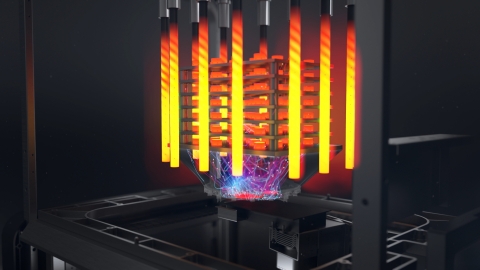Desktop Metal will be developing a sophisticated additive manufacturing (AM) process capable of mass-producing Cobalt(Co)-free hard metal parts for the U.S. Army. The Boston-based company received a multimillion-dollar grant from the Department of Defense (DOD) to carry out the project which is expected to dramatically improve sustainability and provide an environmentally friendly method to mass-produce metals, alloys, cermets, and composite parts with superior properties for both commercial and DOD applications.
Global mass production and turnkey AM solutions provider, Desktop Metals announced on October 7, 2020, it had been awarded Phase I of a three year $2.45 million project to fund the development. The news comes after the U.S. Army patented a novel Co-free tungsten carbide (WC)-based hard metal in January 2020, and then tasked the Army Research Laboratory (ARL) with finding the right process to mass manufacture parts with it.
Relying on its proprietary AM technology, Desktop Metal will develop a cost-effective, high-volume AM process capable of manufacturing the novel Co-free hard metals into complex, net or near-net shaped parts without the use of any tooling. The company’s Production System, that will be used toward the end parts of this project, was designed to 3D print metal parts at scale. It leverages Single Pass Jetting (SPJ) technology to achieve print speeds up to 100 times those of legacy powder bed fusion AM platforms and deliver up to hundreds of thousands or even millions of parts per year at costs competitive with conventional manufacturing, Desktop Metal suggests.
“The success in this project will not only provide the hardmetal community with their eagerly desired Co-free hardmetal solution, but also result in the development of a tool-free processing technique capable of fabricating this class of materials into extremely complex shaped parts at speeds that can rival most other high-volume manufacturing techniques, opening up new horizons in the area of hardmetals and its applications,” said Animesh Bose, Vice President of Special Projects for Desktop Metal and the principal investigator of the three-year project.
Throughout the next three years, Desktop Metal will attempt to develop a feedstock and binder system for the novel Co-free hard metal, use its SPJ process to print at least 200,000 parts in one day from a single machine, and deliver a cost analysis for scaling up the advanced SPJ binder jet manufacturing technique to successfully manufacture at least 500,000 prototype pieces.
“The novel Co-free hardmetal grade is expected to yield a high strength, high toughness, high hardness, and high wear resistance material,” said Nicholas Ku, Materials Engineer at the U.S. Army Combat Capabilities Development Command (CCDC)’s ARL. “We believe combining this novel material with Desktop Metal’s Single Pass Jetting technology will have major applications not only in the defense sector but also in the commercial sector. Further, we believe this combined method will dramatically improve sustainability, reduce the use of a conflict mineral and provide an environmentally-friendly process to mass produce parts with superior properties.”
According to the company, this novel process has the potential to change the landscape of the carbide hard metals market which is projected to grow to $24 billion by 2024 and serves dual-use applications, including cutting tools, abrasion and chemical resistant nozzles, parts for the oil and gas sector, parts for off-road transportation and for the chemical and textile industry, aerospace and defense sector, construction, consumer products, even tools used in agriculture, mining and steel industries and much more.

The Production System is the first metal 3D printing system for mass production of complex metal parts. Image courtesy of Business Wire.
The metal AM project was assigned to Desktop Metal by the U.S. Army Contracting Command – Aberdeen, Research Triangle Park, on behalf of U.S. Army Research Laboratory to the National Center for Manufacturing Sciences (NCMS) Advanced Manufacturing, Materials & Processes (AMMP) Consortium.
The DOD has been looking to develop methods to produce tungsten carbide cermet materials with a cobalt-free, non-hazardous binder system through either conventional or innovative methods. In 2019, the US Army released a Small Business Innovation Research (SBIR) program solicitation seeking to improve ballistic performance by establishing a production technique for WC cermets using the patented Co-free novel binder materials. Evidently, Desktop Metal´s award corresponds to this SBIR program, which plans to utilize the production technique developed in Phase I to fabricate “near-net and net shape projectile cores of the WC-based composition,” followed by full integration of the novel projectiles into small-caliber munition systems, as stated in the solicitation description parameters.
Subscribe to Our Email Newsletter
Stay up-to-date on all the latest news from the 3D printing industry and receive information and offers from third party vendors.
You May Also Like
Gorilla Sports GE’s First 3D Printed Titanium Cast
How do you help a gorilla with a broken arm? Sounds like the start of a bad joke a zookeeper might tell, but it’s an actual dilemma recently faced by...
Nylon 3D Printed Parts Made More Functional with Coatings & Colors
Parts 3D printed from polyamide (PA, Nylon) 12 using powder bed fusion (PBF) are a mainstay in the additive manufacturing (AM) industry. While post-finishing processes have improved the porosity of...
$25M to Back Sintavia’s Largest Expansion of Metal 3D Printing Capacity Since 2019
Sintavia, the digital manufacturing company specializing in mission-critical parts for strategic sectors, announced a $25 million investment to increase its production capacity, the largest expansion to its operations since 2019....
Velo3D Initiates Public Offering in a Bid to Strengthen Financial Foundations and Drive Future Growth
Velo3D (NYSE: VLD) has been among a number of publicly traded 3D printing firms that have attempted to weather the current macroeconomic climate. After posting a challenging financial report for 2023,...
































